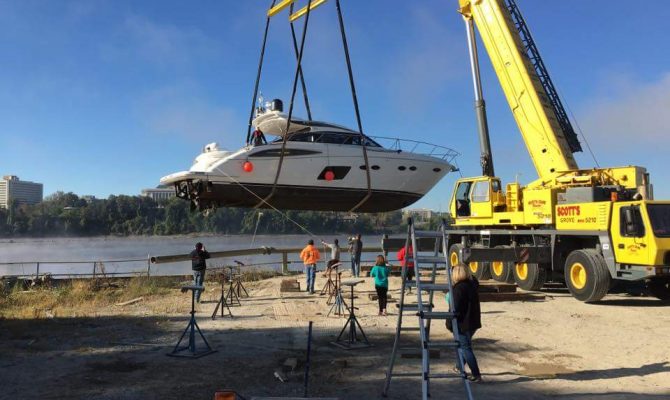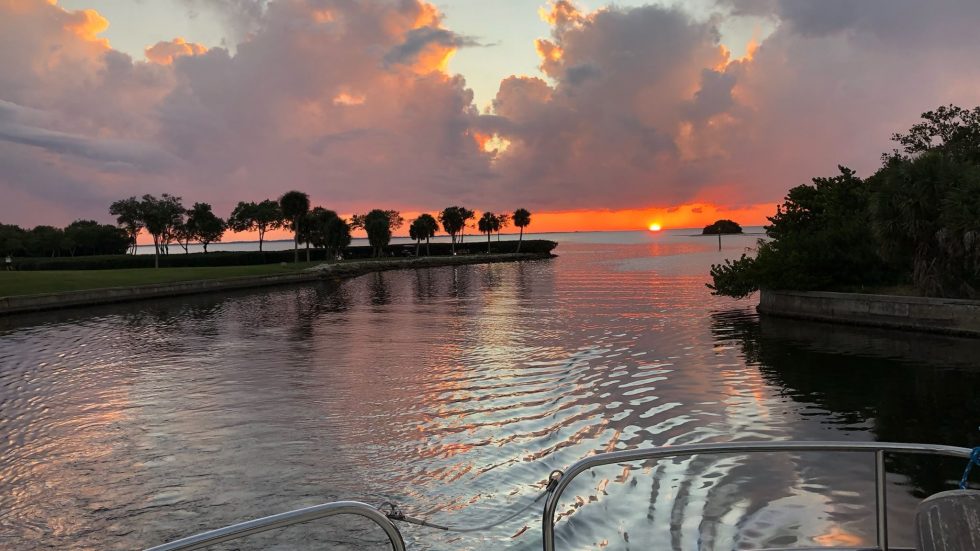Want to know what really happens on a boat delivery? One recent job took me 1,450 nautical miles in 12 days on a Princess V62 motor yacht. We traveled from Lake of the Ozarks, Mo., to Naples, Fla., transiting seven states and 17 locks. Here’s are some of the highlights.
Day 1
The fog was still swirling around us when the crane operator emphatically said, “No, no, no. I can’t let you on that boat when we boom it into the water. Too dangerous.”
Chip and I regrouped. It was our second time trying to convince the crane operator that it was better to put us on the boat than to have us climb down a 30-foot seawall on a ladder covered in debris and old tow hawsers and do a “monkey jump” onto the $2.5 million yacht.
I suggested we sign a waiver. Chip made a last attempt by having the crane operator visualize the boat slipping out of the sling without crew on board and making a solo trip down the Missouri. Reluctantly, he said, “OK, get on the boat and let’s go.”
As the fog cleared, it became one of those glorious, crisp, sunny Midwest fall days. The crane picked up The Princess and lowered us into the river. It was a majestic site, with the Missouri State Capitol building in the background.
The logistics of getting the boat to Jefferson City from Lake of the Ozarks was a story in itself. Though just 60 miles as the crow flies, boats don’t fly. They have to be trucked. And they don’t get under bridges less than 14 feet tall. The 62-foot yacht had to be transported over 180 road miles, through Hermann, Mo., and down topsy-turvy Highway 94. It involved many, many utility trucks, over 300 line lifts and three state patrol escorts.
As we finally hit the water, I climbed into the engine room to make sure the rudder shafts and shaft seals weren’t leaking and the strainers had filled. Chip fired up the twin Caterpillar C18s. After a slight dance with the sling and a thumb’s up from Marine Services Company workers on the bluffs above, we were off.
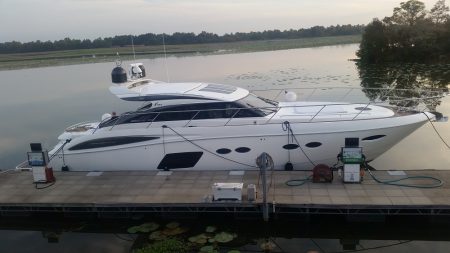
The Princess V62 at the dock
Red on left, green on right, right? The markers indicate the end of wing dams on the Missouri, and missing one can make for a very bad day. Only, the markers were nowhere to be found. The river was running slightly below flood, and most of them were under the water. Except when they weren’t. Every few minutes the current would release its grasp, and a marker would do a “pop goes the weasel” and jump out of the water.
We kept a close eye on the chart plotter and stayed as near to mid-channel as we could. The current was moving a good 5 knots, and at idle the 2,300-horsepower Cats moved the boat at 13 knots. We made good time and knocked out 117 statute miles by 6:30 p.m.
As we passed under the I-70 bridge in St. Charles, Mo., my phone rang. The caller asked if we were the ones causing the delay in his nephew’s wedding. It was a buddy of mine, and he and all the guests had spotted our boat coming downriver just before the ceremony was to begin. A luxury yacht on the Missouri is unusual, and it had stopped the whole show for a few minutes as everyone turned to watch us go by.
Capital City Sand in Jefferson City had made arrangements for us to stay at the St. Charles Sand Plant across from Founders Park. We tied up, fully fendered, at 7:10 p.m. The boat was filthy from the sand plant, but we had a reprieve in our daily cleaning ritual as a rinse with the brown river water wouldn’t help matters. We were in bed by 9:00 o’clock, anticipating a 6:00 a.m. wake-up to resume the trip the next day.
Day 2
It was a bright and sunny morning, with slight surface fog. Visibility was good except for the temperature inversion happening in the cabin, which caused the windows to fog up and glare to be a problem. We each stuck our heads out the side windows and navigated slowly.
We entered the Mississippi River at 8:45 a.m. and reached the Chain of Rocks Canal at 9:00 a.m. A call to the Chain of Rocks Lock got us right in through the auxiliary lock. This was the last and our only lock on Mississippi.
It was slow going on The Big Muddy, with lots of flotsam due to this river also being near flood. We stopped at Hoppies Marina in Kimmswick, Mo. The boat was still a mess after two days, so we decided to clean it and catch up on our river stories with the legendary Fern Hopkins.
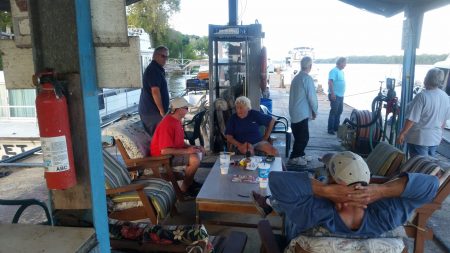
Chatting with Fern Hopkins at Hoppies Marina
As we scrubbed the boat, we watched a 27-foot Bayliner cuddy cabin come screaming in with jerry cans lashed all over its deck. Hoppies is the only place for fuel between Alton, Ill., and Knetucky Lake, unless you carry jugs into town at Cape Girardeau, Mo., or Paducah, Ky., or pre-arrange fuel at a handful of other locations.
For gasoline boats, it’s a real problem, but manageable if you go slow. We figured the Bayliner would fuel up, stay the night and putt slowly downriver, letting the current do most of the work. But about 90 minutes later, the boat tore out of Hoppies, trying to get on plane with all the extra weight it now carried. As it pulled out of site, it was just starting to get its bow down and reach planing speed.
Day 3
Next morning was an early 6:25 start. Again, slow going, with lots of flotsam. After about an hour, a fog bank slammed us as we came around a bend. Our AIS showed a tow a few miles ahead, coming up river. We moved to the near shore and held station until he passed. We slowly made our way downriver for the next 45 minutes, using radar as our primary navigation, listening for other boats and sounding our fog horn every two minutes.
As the fog lifted, we picked up the pace as much as the flotsam would allow us. At 1:00 p.m., we passed through Cape Girardeau. We spotted the same Bayliner tied up to Kidd’s Fuel Dock (no gasoline), running jugs by taxi to and from the boat. We moved on. At about 2:30, the Bayliner made a rude pass around us and cut in front of our bow. Off he went. The story of the tortoise and the hare came to mind.
Shortly thereafter, a 46-foot Bertram gave us a courteous pass on plane. It was a sharp-looking boat, and the captain seemed capable. We figured it to be another delivery driver, perhaps with a little less respect for the owner’s checkbook than Chip and I had.
At 4:00 p.m., we came to the confluence of the Ohio River and made a left turn mid-channel. Minding our wake through this busy marshalling area around Cairo, Ill., we made plans for where to stop for the evening. As we approached Olmsted Lock, I radioed the lockmaster, who said we could follow a line boat through the lock if we’d like and anchor above the old Lock 53 for the evening.
We did a high-five on our progress for the day and set our hook at 6:50 p.m.
Day 4
Everyone seems to complain about Lock 52 just above Metropolis, Ill. It’s one of the oldest in the Corps of Engineers system and frequently needs maintenance. Stories abound about being help up for days (or at least overnight) and pleasure craft being ignored.
But in my 10 or so times through the area, I’ve always been treated with courtesy and the lockmasters have always tried their best to “fit” me in between tows. The lock has a primary and an auxiliary chamber. If both are operational, the lockmaster will send someone over to the auxiliary lock to let you through.
We contacted Lock 52 at 8:25 a.m. and cleared through the auxiliary lock at 9:05. So much for the dreaded choke point.
We entered the Cumberland River shortly thereafter. Some captains will take the Tennessee River to the Kentucky Dam Lock rather than take the Cumberland River to the Lake Barkley Lock. But Kentucky Dam Lock is operated by the Tennessee Valley Authority, and it doesn’t have the two-lock rule for pleasure craft. Though it’s 20 miles shorter, the time you save can be wasted by having to wait just one extra lockage.
We chose to take the Lake Barkley Lock. It’s 30 miles from the Ohio River, and the going is fairly slow. There are a lot of fishermen in small boats, and putting a 62-foot yacht on a plane would swallow anything in the neighborhood. So, we took our time to get there.
A down-bound tow was just entering the lock, and the lockmaster said we’d be locked through after it cleared. Thankfully, we’d decided to drop a hook off to the side of the lock chamber shortly after we arrived, because it was a long wait. We showered, changed clothes, combed our hair and straightened the clutter that had gathered on the boat since we departed. The owner was going to join us at Green Turtle Bay Resort & Marina in Grand Rivers, Ky., after all.
We finally cleared the impressive Barkley Lock at 4:30 p.m. For those folks doing the Great Loop, this is the second largest lift you will encounter at 57 feet.
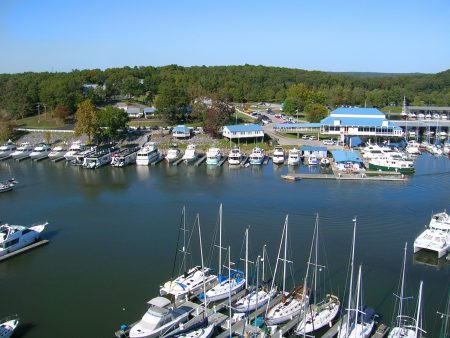
Green Turtle Bay Resort & Marina
We were greeted at the fuel dock of Green Turtle Bay by none other than Bill Gary IV, owner of the facility. He handed me a bottle of wine. Wow, did I feel special! It was a nice bottle, too, and a brand I was familiar with. Then Bill said a friend of mine had dropped it off because I’d left it on his boat two weeks ago when I was down visiting and he wanted to give it back. So much for that special feeling.
Right behind Bill was our yacht’s owner, Jack, and I was meeting him in person for the first time. My first impression was good. He had a pleasant demeanor and was quick with a smile and laugh. He gave the boat a once over and sighed, “Well, guys, I’m a bit of a neat-nick. I guess I’m going to have to get over that while you’re on board.”
We had portable navigation equipment, AIS, chart plotters, handheld VHF radios, iPads, phones and more all plugged into a cascade of outlets — plus two pairs of binoculars kicking around, chart books, logs. OK, maybe one or two candy wrappers hadn’t make the trash can. But we were in delivery mode. I’d say we are “functionally cluttered.” We all laughed about the boat’s storage being consumed by liquor and wine glasses and called a truce.
Later that night, we had dinner at Green Turtle Bay Yacht Club and got to know our yacht’s owner better. He was a nice guy. He’d made his money the old-fashioned way: working his butt off, building a business from the ground up and then selling before he got too old to enjoy it. He’d fallen in love with the boat we were moving for him and “had to have it.” The only one available in the U.S. had been at the Lake of the Ozarks — and, so, here we were.
Read the remainder of the story in the August issue of HeartLand Boating, when we continue the voyage from Grand Rivers, Ky., to Naples, Fla.
[author] [author_info]Capt. Matthew Hahn is a licensed 100 Ton USCG Master. When he’s not delivering yachts, he works for TowboatUS, pilots an excursion boat out of Grafton, Ill., and teaches USCG Licensing courses for Worldwide Marine Training. He can be contacted through his website at aquatic-expeditions.com.[/author_info] [/author]

